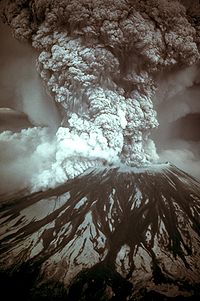
Photo from wikipedia
Abstract Landslides have long been considered one of the main erosive drivers that sculpt hillslopes over time. Tectonic forces raise slopes that can be sculpted by climate and the degree… Click to show full abstract
Abstract Landslides have long been considered one of the main erosive drivers that sculpt hillslopes over time. Tectonic forces raise slopes that can be sculpted by climate and the degree to which they can be sculpted depends upon the underlying lithology and hillslope geomorphology. Landslides destroy life and property and contribute to the evolution of mountain landscapes by generating and transporting hillslope sediments. In this study, we investigate the dynamics of soil-mantled hillslopes in eastern Oklahoma and western Arkansas, USA, by mapping shallow landslides, evaluating the frequency and magnitude of the landslides, and quantifying the surface geometries. We mapped 185 shallow landslides in a 150 km2 area. The approximate ages of landslides and the frequencies and magnitudes (area, volume and runout) were estimated using historical aerial photographs. The landslide database was then used to compute rate of landslide occurrence and sediment yield. In addition, landslide surface geometries, including slope, curvature and surface roughness, were determined from 10 m NED and 2 m LiDAR elevation data. The hillslope susceptibility studies, derived from elevation data, were augmented by our review of common historical accounts that link landslides in the study region to the 1952 M 5.4 El Reno, Oklahoma earthquake ~300 km away. In light of that case study, we determined the frequency of historical earthquakes that impart >2 kPa dynamic stresses for the study area since 1900 and find an increased potential for dynamic stress perturbation of landslide activity since ~2010. All these characteristics were then evaluated to understand the dynamics of hillslopes and hillslope susceptibility to shallow landslides. Frequency assessment of mapped landslides suggested that frequency of landslides increased significantly during 2005–2016 compared to 1995–2005. On average ~10 shallow landslides occurred every year during 2005–2016. These landslides alone contributed ~1.5 × 105 m3/yr (sediment yield rate: ~0.10 cm/yr) of sediments. Surface roughness values were relatively higher in landslide areas compared to that of surrounding non-landslide areas. The surface roughness index mapped ~84% of observed landslides, and suggests that the index could be used to map hillslope susceptibility to landslides for future planned studies.
Journal Title: Geomorphology
Year Published: 2020
Link to full text (if available)
Share on Social Media: Sign Up to like & get
recommendations!